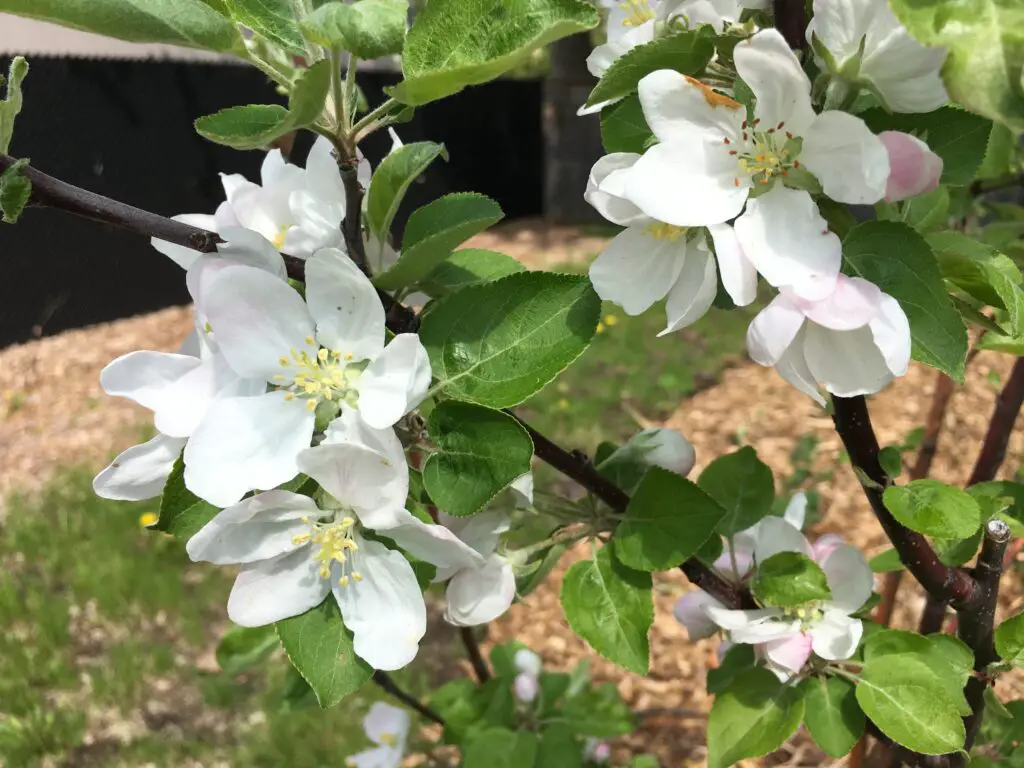Apple blossoms and apple leaves contain small amounts of hydrocyanic acid – or “cyanide”. However, both the flowers and leaves on an apple tree are edible in small quantities and are high in antioxidants and minerals.
Dried apple blossoms can be steeped to make teas, aged in vodka, flavour jellies, or used fresh as a garnish.
How To Pick Apple Blossoms
First check out our guide on when your apple tree will be in full bloom. When your apple tree is in full bloom, slide your index finger and middle finger under the apple blossom and gently pull towards you to detach the apple blossom from the tree.

Be aware, the apple tree needs the flowers to get pollinated in order to produce apples. If you pick all the apple blossoms, you won’t get any apples that growing season.
How to Dry Apple Blossoms
If you own a dehydrator, you can lay the apple blossoms in a single layer over the tray of your dehydrator and turn it on. Use the lowest temperature setting, and dehydrate for 3-6 hours or until completely dry. Once your apple blossoms cool, store them in an airtight container.
If you don’t own a dehydrator, you can lay the apple blossoms flat on a baking tray and leave them out to dry on a warm and sunny day.
How To Make Apple Blossom Tea
Apple blossom tea has a fresh and sweet aftertaste. The tea is a great stress reliever, eases nerves, improves your digestive system, and can clear acne.
- Add 1 teaspoon of dried apple blossoms to your tea cup.
- Pour 1 cup of boiling water over the apple blossoms and let steep for 10 minutes.
- Strain out the apple blossoms and enjoy your herbal apple blossom tea
Apple Tree Leaves
Apple tree leaves are edible and have cooling and astringent properties.
Like most woody plant leaves, apple tree leaves are high in fibre, which is the amount of cellulose and lignin that are in the plant. Cellulose makes up 33% of apple tree leaves and surrounds the cell walls, while lignin provides the mechanical support for leaves and supplies the strength and rigidity of plant walls. Lignin provides the structural strength needed by large trees to reach heights in excess of 100 m. Without lignin these trees would collapse on themselves.
Unlike annual vegetables, the high lignin and cellulose content of mature apple tree leaves and other woody plants means humans don’t get the full benefit of absorbing the most nutrients from the leaves themselves, since we cannot digest lignin and cellulose. In fact, only fungi can digest lignin, which is why you most often see mushrooms growing in your yard above old tree stumps or in wood chip mulch. They are hard at work breaking down the rotting wood.
This does not mean that apple tree leaves are harmful or poisonous, it just means they are mainly used in teas or for topical treatments rather than ingested.
Apple tree leaves are also high in polyphenols, which are organic chemicals high in antioxidant and anti-inflammatory properties that help fight against aging signs and slow the growth of tumours. In plants, polyphenols help defend against attack by insects and give plants their colour.
When to Pick Apple Tree Leaves
Be sure to pick only apple leaves that are organic, and have not been sprayed with any chemicals. Apple leaves should be picked in early-spring while they are young, tender and healthy before the tree starts to produce apples. These young shoots can be eaten directly off the tree. As the apple tree matures, the leaves become more fibrous and harder to digest as they grow more cellulose and lignin. Young apple leaves make a great garnish to salads or meat dishes.
Apple Leaf Tea
Steeping apple tree leaves extracts the alkaloids that protect the plant from pests. Apple tree leaves steeped in boiling water are great for relieving heart burn, acid reflux, upset stomach and diarrhea and have cooling and astringent properties.
To make apple leaf tea, pick a handful of fresh young apple tree leaves. Rip them up in your hand and toss them into a tea cup. Pour boiling water over the leaves and let steep for 10-15 minutes. Strain the leaves out, and enjoy your cooling herbal apple leaf tea.
Apple Leaf Treatment
Apple leaves contain phloretin, which is a crystalline antibacterial substance that has been shown to inhibit the growth of a number of bacteria. Apple leaves contain 7.5 times more phloretin than apples themselves.
Due to their astringent and antiseptic qualities, apple leaves make an excellent topical application. They make excellent first aid applications when they are chewed and placed on a fresh wound to prevent infection, to reduce inflamed swelling, and on infected bug bites or scratches.
As well, chewing apple leaves releases the alkaloids in the leaves which can be swished around the mouth to strengthen your gums.
There you have it, everything you need to know about edible apple blossoms and apple leaves.
Related Questions
When will my apple tree bloom? Apple trees will bloom in early spring between mid-April and mid-May after having met the required chill hours during winter dormancy. Read our post on apple tree blooms to know exactly when your apple tree will bloom.